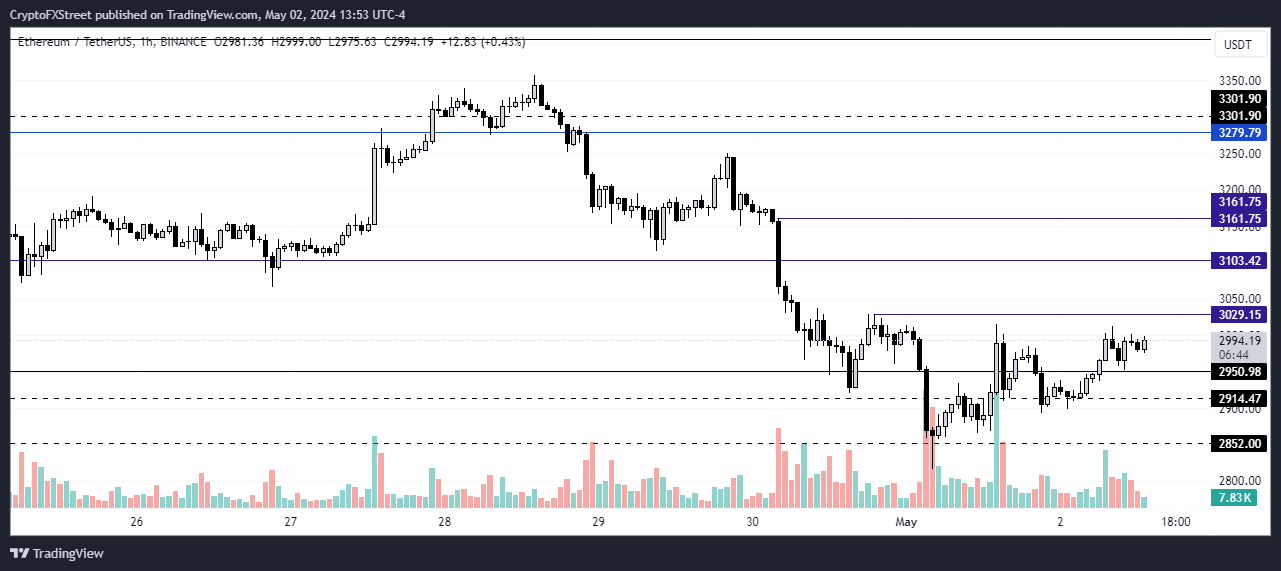- Ethereum would likely sustain trading inside key range despite recent sharp movements outside it.
- Hong Kong spot Bitcoin and Ethereum ETFs recorded a second day of very low trading volume on Thursday.
- Bloomberg analyst James Seyffart doesn’t see spot Ethereum ETFs happening until 2025.
Ethereum (ETH) is beginning to show signs of recovery on Thursday despite a second consecutive day of poor performance in Hong Kong’s spot Ethereum ETFs. Bloomberg analyst James Seyffart has also shared that a spot Ethereum ETF may not happen in the US in 2024.
Daily digest market movers: Spot Ethereum ETFs unlikely in 2024
Ethereum ETFs are trending again following recent developments. Here are the latest market movers for the top altcoin:
- Hong Kong’s spot Bitcoin and Ethereum ETFs recorded another day of underwhelming performance, as their total trading volume was approximately $8.75 million. The three Ethereum ETFs managed a trading volume of about $600,000.
The low volume may be attributed to the recent crypto market dip, as investors are exercising caution. This aligns with the current ratio of the Ethereum Fear and Greed Index, which has declined significantly, dropping to 40 at the time of writing. While that signifies a neutral state, a further drop could quickly turn on the fear alert, signifying a potential bearish trend.
- In an interview with Altcoin Daily, Bloomberg analyst James Seyffart shared that the odds of an Ethereum ETF happening in 2024 is low, adding that an approval in 2025 looks more likely. He pointed out that a SEC approval of spot ETH ETFs in May is highly unlikely, considering there have been no positive signs.
“Our official stat is 25%. We’re gonna have to lower that in the future as we are not seeing any movements,” he said. The SEC must decide on Van Ecks’ spot Ethereum ETF application on May 23.
Also read: Ethereum dips below key level as Hong Kong ETFs underperform
- However, he doesn’t expect the SEC to deny ETH ETFs by going nuclear and calling them security, as it would invite a plethora of lawsuits. Instead, he expects the regulator to come up with a word salad—like leaning on weak correlations—as a reason for denial. Seyffart also noted that the outcome of the US presidential election may play a role in the final decision on ETH ETFs.
ETH technical analysis: Ethereum to rise within key range
After the recent downturn that saw its price reaching $2,816 on Wednesday, Ethereum is looking likely to recover earlier losses as it’s currently trading close to $3,000. While many have turned bearish following recent price movements, ETH may not sustain any decline outside the $2,852 to $3,300 range for too long.

ETH/USDT 1-hour chart
We can also see this from the decline in Ethereum long liquidations, which sat around $34 million in the past 24 hours. Ethereum open interest (OI) has also risen slightly by 2% on Thursday, indicating traders are beginning to open positions again.
As a result, ETH’s potential to decline further is unlikely. If ETH breaks past $3,029, it may rise further to cover the liquidity void of April 30.
This thesis would be invalidated if an upcoming macro event disrupts market dynamics.
Ethereum development FAQs
After the Merge, the Ethereum community is looking at the Sharding upgrade next, which has been slated for sometime later in the year. The development can be summarized in four words, “scalability through more efficient data storage.” The software update will increase the capacity of the blockchain, widening the amount of data that can be stored or accessed. At the same time, all services running atop the Ethereum blockchain will enjoy significantly reduced transaction fees.
A fork is the splitting of a blockchain after developers agree and proceed to implement upgrades. The decision comes after these developers reach a consensus for a software upgrade. The ensuing part will see one part continue with the status as is, while the other one will proceed with new features combined with the former ones. A hard fork basically entails permanent divergence of a new side chain from the original one, while a soft fork is doing the same, only difference being that it is temporary.
EIP-4844 is an improvement proposal for the Ethereum network. The upgrade promises reduced gas fees, which is a valuable offering considering the high transaction cost that continues to daunt crypto players. It has been a long-standing concern for the Ethereum network. The proposal is also referred to as “proto-Danksharding,” with an unmatched ability to increase the speed of transactions on the Ethereum blockchain. At the same time, it helps to reduce the transaction cost as everything becomes decentralized.
Gas token is a new, innovative Ethereum contract where users can tokenize gas on the Ethereum network. This means they can store gas when it is cheap and start to deploy the gas once the market has shifted to the north. The use of Gas token helps to subsidize high gas prices on transactions, meaning investors can do everything from arbitraging decentralized exchanges to buying into initial coin offerings (ICOs) early.

























